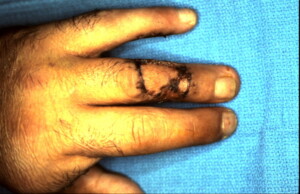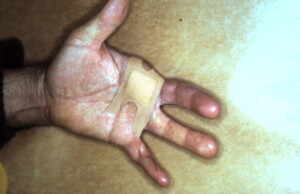Power Saw – Miter Injury
Table saws have long been known as one of the most dangerous tools to work with. In fact, according to the Consumer Product Safety Commission, there are nearly 40,000 blade injuries every year. Nearly 4000 of these injuries involved amputation. The economic cost of these injuries amounts to more than $2.3 billion annually.
This case involves the left non-dominant hand of a wood worker who sustained amputation of the index finger. The middle finger was salvaged by using a filet flap from the index finger ray amputation and full thickness skin grafts to the ring finger. The little finger sustained a de-gloving type injury and was closed primarily, understanding that an additional procedure may be necessary. Indeed skin loss and contracture of the little finger ensued requiring a delayed cross finger flap to correct this problem. The patient regained reasonable function including lateral pinch, tip pinch and gross grasp.
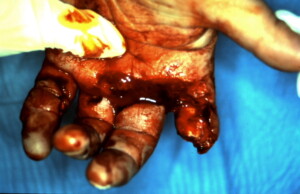 The saw traversed the palm involving all 4 digits.
The saw traversed the palm involving all 4 digits.
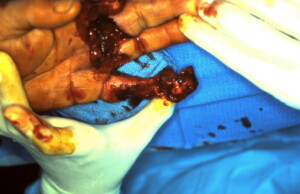 Significant palmar skin loss of middle and ring fingers and the skin of the little finger.
Significant palmar skin loss of middle and ring fingers and the skin of the little finger.
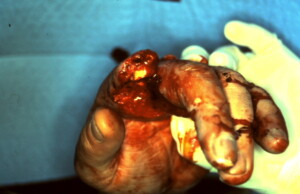 Amputation of the index finger.
Amputation of the index finger.
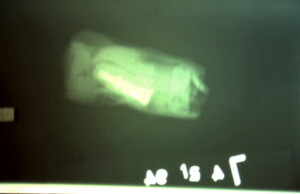 X-ray of amputated segment shown bony level to be at the proximal inter-phalangeal joint.
X-ray of amputated segment shown bony level to be at the proximal inter-phalangeal joint.
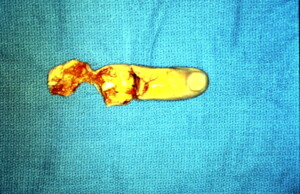 Index finger. Secondary to the multiple levels of injury replantation of this digit was not feasible.
Index finger. Secondary to the multiple levels of injury replantation of this digit was not feasible.
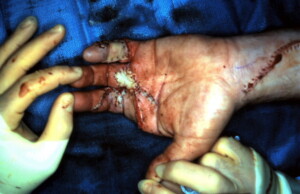 A Completion amputation proximal to the metacarpal head was chosen for the index finger so that the remaining soft tissue of the index finger could be used to resurface the soft tissue loss of the palmar wound of the middle finger. A skin graft was applied to the ring finger and the little finger de-gloving injury was closed primarily although palmar skin viability was questionable.
A Completion amputation proximal to the metacarpal head was chosen for the index finger so that the remaining soft tissue of the index finger could be used to resurface the soft tissue loss of the palmar wound of the middle finger. A skin graft was applied to the ring finger and the little finger de-gloving injury was closed primarily although palmar skin viability was questionable.
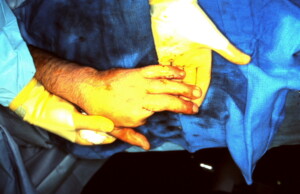 Dorsal view after first operation.
Dorsal view after first operation.
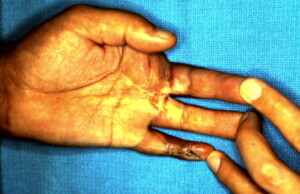 Palmar view of the hand after allowing the little finger skin to completely demarcate in preparation of a cross finger flap.
Palmar view of the hand after allowing the little finger skin to completely demarcate in preparation of a cross finger flap.
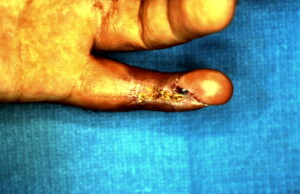 Close up view of the poor quality skin on the volar surface of the little finger.
Close up view of the poor quality skin on the volar surface of the little finger.
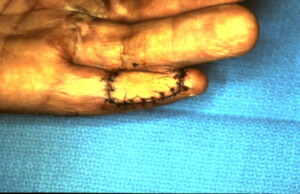 A cross finger flap where skin from the dorsal aspect of the ring finger was attached to the little finger was performed. The fingers are separated in around 10 days. Volar view.
A cross finger flap where skin from the dorsal aspect of the ring finger was attached to the little finger was performed. The fingers are separated in around 10 days. Volar view.
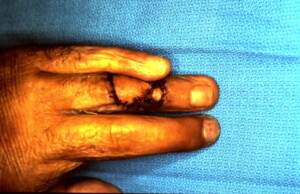 Dorsal view of the two fingers prior to the division and insetting of the cross finger flap. Full thickness skin graft on the donor finger is visualized.
Dorsal view of the two fingers prior to the division and insetting of the cross finger flap. Full thickness skin graft on the donor finger is visualized.
Immediately following division and insetting of the cross finger flap. Dorsal view.
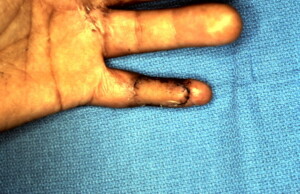 Volar view of cross finger flap immediately after division and insetting. The poor quality skin has been replaced with supple good quality skin.
Volar view of cross finger flap immediately after division and insetting. The poor quality skin has been replaced with supple good quality skin.
Early postoperative result showing healed wounds.Band-aid covering trivial wound sustained inadvertently.




